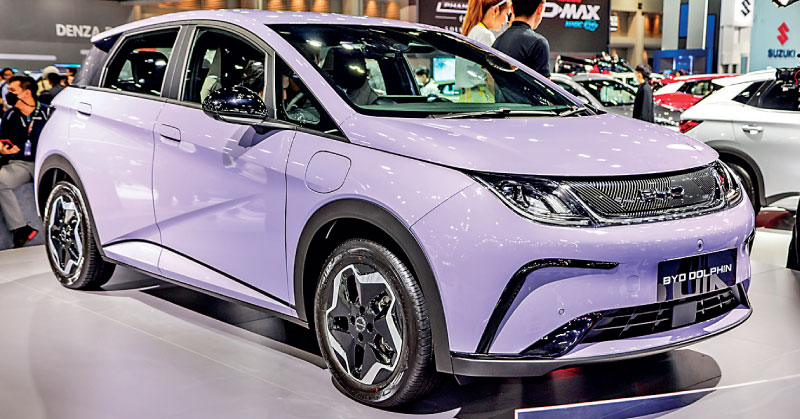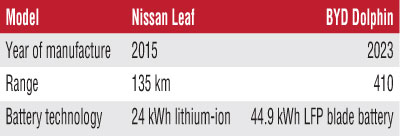Monday Dec 29, 2025
Monday Dec 29, 2025
Thursday, 4 January 2024 02:08 - - {{hitsCtrl.values.hits}}

 By Prof. Anura Wijayapala
By Prof. Anura Wijayapala
A common unfortunate experience shared by Sri Lankans is being exposed to clouds of unpleasant emissions from internal combustion engine (ICE) vehicles. This is a growing challenge, especially considering Sri Lanka’s ageing vehicle fleets. Accordingly, 70% of Sri Lanka’s total air pollution is attributed to the transport sector.
According to statistics released by PUCSL, there are more than 1.1 million internal combustion engine (ICE) vehicles operating in Sri Lanka excluding three wheelers and motor bicycles. There are over one million three wheelers and over 4.5 million motor cycles all running on ICEs. Still, fewer than 10,000 electric vehicles (EVs) on the roads while there are substantial number of plug-in hybrids (PHEVs) and hybrid electric vehicles (HEVs) which are powered mainly by ICEs. This means that the development of Sri Lanka's transport sector has created a significant economic burden in the past decades. It is time we modernize our vehicle fleet, which has been kept on hold due to the recent economic crisis.
Further, adding to the burden, Sri Lanka imports 100% of its fuel requirement, of which 70% is consumed by the transport sector and according to the latest official data released by the Ministry of Power and Energy, Sri Lanka's total fuel consumption as of August 2023 stood at over LKR. 2 billion despite pretty high fuel prices.
With the depletion of global crude oil resources, uncertainty in global price hikes, and current environmental issues such as climate change, air pollution, and noise pollution, an alternative to conventional vehicles is now more than necessary.
The Minister of Transport and Highways, Dr. Bandula Gunawardane, recently unveiled a government plan 2024 to be the "E-mobility year." As a result, there is greater interest in EVs in Sri Lanka than ever before. However, can EVs offer a viable solution for Sri Lanka’s transportation challenge?
What is the way forward?
I believe that a partial or complete replacement of ICE with EVs could lead to an overall reduction in fuel consumption further. This enables reduced emissions, which could help improve the quality of health and reduce Sri Lanka’s overall greenhouse gas emissions.
Research conducted by the University of Leeds, UK, shows that this may be a feasible option. The research found that electric cars are cheaper to own and run than petrol or diesel cars in the UK, US, and Japan, partly because of government support. It is also said that electric cars are expected to become the cheapest option, even without subsidies. However, for Sri Lanka, it is disheartening to observe that the growing demand for electric cars in 2015 was hit due to increased taxes in 2016 and an import ban on vehicles in 2020.
If Sri Lanka wishes to accelerate the growth of EVs, our government can take examples from foreign governments like the US, the UK, and China. For example, tax reduction components and providing concessions can encourage widespread EV adoption.
Adopting alternative energy sources not only contributes to foreign exchange savings on fossil fuels but also encompasses reductions in expenditures related to vehicle spare parts, maintenance accessories, and lubricants. This multifaceted approach mitigates reliance on traditional and often depleting resources and opens avenues for creating new business ventures and employment opportunities. By embracing sustainable practices, societies benefit economically, environmentally, and socially, paving the way for a more resilient and forward-thinking future.
According to the Nationally Determined Contributions report, Sri Lanka has committed to reducing GHG emissions by 25% from the energy sector and 10% from other sectors (including transportation) against the business-as-usual greenhouse gas emission projections in 2030. Therefore, accelerating the adoption of EVs can be considered a ‘win-win’ situation for Sri Lanka and its people.
One of the best ways of achieving this target for Sri Lanka would be to follow the Norwegian government's example. They plan to make all new cars sold in the country zero-emission by 2025, primarily focusing on electric or hydrogen-powered vehicles. As of the end of 2022, 20% of registered cars in Norway were battery-electric vehicles (BEVs), holding a market share of 79.2%. This rapid transition is credited to well-implemented policies and various government incentives; as such, Sri Lanka can also decide on following similar policy-based principles.
The role of energy
In 2022, Sri Lanka's overall electricity generation amounted to 15.9 terawatt-hours, as reported by Ceylon Electricity Boards Statistical report . Additionally, renewables constituted 52.1% of the total electricity generation in the same year, according to data from the same report.
Hence, even with the widespread adoption of electric vehicles, the increase in electricity demand is not expected to significantly impact the government’s overall electricity production or grid capacity in Sri Lanka over the next decade. For example, by encouraging EV charging during off-peak times with lower tariffs, overall load curve of the electricity demand can be further flattened, making the capital investments more efficient.
Based on this data, it is evident that individuals, even without solar power, will be able to discover that running an electric vehicle is much more cost-effective than using an ICE vehicle in Sri Lanka.
Diesel used in power plants can generate more electricity than directly using it in vehicles. While a litre of fuel in an ICE vehicle covers 10-12 km, that same amount in an efficient power plant can produce about 5 units of electricity. Even accounting for a hypothetical loss of 1 unit during generation, transmission and distribution, the remaining 4 units can power a vehicle for approximately 24 km. This demonstrates the efficiency and environmental advantages of using diesel for electricity generation compared to its direct combustion in transportation.
For those already utilizing solar power, there is zero cost involved. However, for non-solar users, a maximum domestic electricity charge will cost approximately Rs. 80. In contrast, an external charging facility supplied by the service provider costs approximately Rs. 160 per unit at present. Whatever the source, it is still economically sensible. Even at Rs. 160 per unit, when an EV runs 6km, it costs a little over 25 Rs/km while ICE engine driven vehicles will cost significantly more. This is in addition to a very much lower vehicle maintenance costs.
Advancements in Technology
Further, we have seen a vast improvement in battery technology, which has changed the EV industry—introducing energy-efficient batteries that extend the overall travel range and charge time.
The inaugural Nissan Leaf, introduced in 2010, featured a modest 24kWh battery with a driving range of 100 km to 135 km when charged overnight. Over the years, the industry has undergone a paradigm shift witnessing a significant leap in energy storage capabilities. Currently, the 3rd generation of electric cars hold a 60 kWh battery, which enables EVs to extend their driving range beyond 350 km to 450 km on a single charge in under 45 minutes or less.
The synergy of innovation, engineering prowess, together with crash and post-crash safety tests has culminated in these cutting-edge batteries, affirming the viability of electric vehicles as a practical, safe and formidable alternative in the global automotive landscape.
To illustrate, let's take the most commonly used EV in Sri Lanka and the latest addition to the market—BYD, introduced through the recent partnership with John Keells Holdings PLC, aimed at providing zero-emission vehicles to Sri Lanka.
 Consumer benefits
Consumer benefits
The total private cost of ownership of cars includes the purchase price and depreciation, taxation, insurance, and fuel or electricity infusion. Let us first factor in the most crucial cost-effectiveness calculation when choosing an EV over an ICE vehicle.
Similarly, maintenance costs play a significant role in comparing traditional ICE vehicles to electric cars. ICE vehicles incur substantial expenses for engine upkeep as they age. Routine tasks such as changing engine oil, coolant, transmission fluid, and belts contribute to the overall cost of ownership.
In contrast, electric cars lack internal combustion engines, eliminating these specific maintenance expenses. The most substantial maintenance cost for an electric vehicle typically arises from replacing the battery pack, an expense that may only occur after 10 to 13 years of use. This demonstrates that using electric vehicles is the most cost-effective solution for consumers.
In conclusion, I have personally experienced the advantages of transitioning to an EV, particularly evident during the peak of the fuel crisis when I avoided long queues at gas stations. Despite owning an older EV, I have enjoyed substantial cost savings in terms of both fuel purchases and maintenance expenses. I am confident that these benefits can be extended to other vehicle users, especially with the introduction of newer, high-quality EVs entering the market.
This positive trend underscores the need for the government to actively promote the adoption of EVs in Sri Lanka. A gradual and sustainable phase-out of ICE vehicles over the coming years is crucial. Such a transition not only aligns with the aspirations of the Sri Lankan population, providing affordable mobility for all but also brings significant advantages to both the government and the economy. It is imperative for policymakers to encourage and facilitate the increased influx of EVs, marking a transformative and environmentally responsible shift in the automotive landscape.
(The writer is the Professor of Electrical Engineering at the University of Moratuwa and was the former Chairman of the Ceylon Electricity Board)